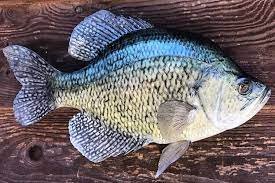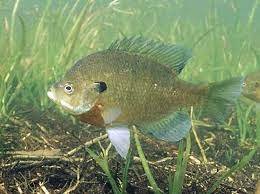Crappie Facts, FAQs, Behaviour, Habitat, Conservation and More

Crappie Facts | Description | Distribution and Habitat | Conservation | Behaviour and Ecology | Interaction with Human | Cultural | Interesting facts | frequently asked questions about Crappie
If you’re a fan of freshwater fishing, then you’ve likely heard of the crappie – a small, but mighty fish that’s popular among anglers of all levels. The crappie, also known as the papermouth, is a member of the sunfish family and is native to North America. With its distinctive silver and green scales and black speckles, the crappie is a beautiful fish that can be found in a variety of freshwater habitats, from lakes and rivers to ponds and reservoirs. But what really sets the crappie apart is its delicious, white, flaky flesh, making it a favorite among fish enthusiasts who love to catch and cook their own fresh catch. So whether you’re an experienced angler or just getting started, the crappie is a fish that’s sure to provide a thrilling and satisfying fishing experience.
Taxonomy of Crappie
| Kingdom | Animalia |
|---|---|
| Phylum | Chordata |
| Class | Actinopterygii |
| Order | Perciformes |
| Family | Centrarchidae |
| Genus | Pomoxis |
| Species | Pomoxis annularis (white crappie) and Pomoxis nigromaculatus (black crappie) |
Morphology of Crappie
| Body Part | Description |
|---|---|
| Body Shape | Compressed, with a deep and round body |
| Coloration | Silver-green with black speckles |
| Fins | Dorsal and anal fins are nearly identical in shape and size, located towards the back of the body |
| Size | Typically around 9-10 inches in length, although can grow up to 19 inches |
| Weight | Typically around 1/2 to 2 pounds, although can weigh up to 5 pounds |
| Scales | Cycloid scales, moderately large |
| Mouth | Terminal mouth, with a protruding lower jaw |
| Teeth | Small, pointed teeth on the tongue and roof of the mouth |
| Eyes | Large and set high on the head |
| Lateral Line | Well-developed, running down the length of the body |
| Operculum | Hard bony structure that covers and protects the gills |
| Swim Bladder | Well-developed and serves as a buoyancy organ |

Description of Crappie
The crappie fish, also known as the papermouth, is a small but mighty freshwater fish that is popular among anglers of all levels. It is a member of the sunfish family and is native to North America. The crappie has a compressed body shape with a deep and round body. It has silver-green scales with black speckles that give it a distinctive appearance. Its dorsal and anal fins are nearly identical in shape and size and are located towards the back of the body.
The crappie typically grows to be around 9-10 inches in length, although it can grow up to 19 inches. It typically weighs around 1/2 to 2 pounds, although it can weigh up to 5 pounds. The crappie has cycloid scales that are moderately large and a terminal mouth with a protruding lower jaw. It also has small, pointed teeth on the tongue and roof of the mouth.
The crappie has large, set-high eyes and a well-developed lateral line that runs down the length of the body. It has a hard bony operculum that covers and protects the gills and a well-developed swim bladder that serves as a buoyancy organ.
Overall, the crappie fish is a beautiful and fascinating species that is highly prized by freshwater anglers for its delicious, white, flaky flesh. Whether you are an experienced angler or just getting started, the crappie is a fish that is sure to provide a thrilling and satisfying fishing experience.
Distribution and habitat of Crappie
The crappie fish is native to North America and can be found throughout the continent in a variety of freshwater habitats. The two species of crappie are the white crappie (Pomoxis annularis) and the black crappie (Pomoxis nigromaculatus). The white crappie is more common in the central and eastern United States, while the black crappie is more common in the northern and eastern United States and Canada.
Crappie fish prefer to live in clear or slightly turbid waters that are well-oxygenated and have a moderate current. They can be found in a variety of freshwater habitats, including lakes, ponds, rivers, and reservoirs. Crappie are known to prefer habitats with structure, such as submerged logs, weed beds, and other debris. They also tend to school together in groups, especially during the spawning season.
Overall, the distribution and habitat of the crappie fish make it a popular target for freshwater anglers, as it can be found in a variety of settings and provides a challenging and rewarding fishing experience.
Behaviour and Ecology of Crappie
Crappie fish are known for their schooling behavior, especially during the spawning season. They are active feeders and can often be found in shallow waters near structures, where they prey on small fish, insects, and other aquatic invertebrates. They are also known to feed at dawn and dusk, making these times of day optimal for fishing.
During the spawning season, which typically occurs in the spring, crappie will move into shallow water near structures to spawn. Females can lay up to 100,000 eggs, which adhere to submerged vegetation or other structures. The male will guard the eggs and the resulting fry until they are able to swim and feed on their own.
Crappie are an important food source for a variety of aquatic predators, including largemouth bass, northern pike, and other larger fish. They are also a popular game fish for freshwater anglers, as they provide a challenging and exciting fishing experience.
Overall, the behavior and ecology of the crappie fish make it a fascinating and important species in the freshwater ecosystem. Its schooling behavior, feeding patterns, and spawning habits all play a vital role in the food web and contribute to the overall health and balance of freshwater ecosystems.
Conservation of Crappie
Crappie fish populations have been impacted by a variety of factors, including habitat destruction, pollution, overfishing, and the introduction of non-native species. As a result, efforts have been made to conserve and protect crappie populations and their habitats.
One of the key strategies for conserving crappie populations is to limit the number of fish that can be harvested by anglers. This can be achieved through the implementation of fishing regulations, such as size limits, bag limits, and closed seasons. These regulations help to ensure that crappie populations are not overexploited and that there are enough fish to maintain healthy populations.
Another important strategy for conserving crappie populations is to protect and restore their habitats. This can involve the preservation of wetlands and other important habitats, as well as the restoration of degraded habitats through measures such as the removal of invasive species and the planting of native vegetation.
Research is also an important component of crappie conservation efforts. By studying the behavior, ecology, and genetics of crappie populations, scientists can better understand the factors that impact their survival and develop effective conservation strategies.
Overall, the conservation of crappie fish is important for maintaining healthy and balanced freshwater ecosystems. By implementing strategies to protect and restore their habitats and limit overfishing, we can help ensure that crappie populations continue to thrive for future generations to enjoy.
Interaction with Human of Crappie
Crappie fish are an important target for freshwater anglers, as they provide a challenging and exciting fishing experience. They are considered a popular game fish in many regions of North America, and are often targeted by recreational anglers using a variety of techniques, such as jigging, trolling, and fly fishing.
Due to their popularity among anglers, crappie populations can be impacted by overfishing. As a result, regulations have been put in place to limit the number of crappie that can be harvested by anglers. These regulations typically include size limits, bag limits, and closed seasons.
Crappie fish are also sometimes used as a food source by humans. They are considered a tasty and nutritious fish, and can be prepared in a variety of ways, such as fried, baked, or grilled.
Overall, the interaction between crappie fish and humans is largely positive, as they provide recreational and culinary benefits. However, it is important that we manage our interactions with these fish in a sustainable way to ensure their populations remain healthy and stable. This includes limiting overfishing and protecting their habitats.
Cultural and Historical Significance of Crappie
Crappie fish have played an important role in the culture and history of many Native American tribes in North America. They were often used as a source of food and were considered an important part of their diet. The fish were also used in various cultural ceremonies and rituals, such as the Native American Green Corn ceremony.
In addition to their cultural significance, crappie fish also have a rich historical significance. They were first described and named by naturalist Samuel L. Mitchill in 1815, and were later studied by other famous naturalists such as John James Audubon.
Crappie fish have also been an important part of recreational fishing in North America for many years. They are a popular target for anglers, and have been featured in many fishing tournaments and competitions. In fact, the world record for the largest black crappie caught on record is 5 pounds, 7 ounces and was caught in Missouri in 2006.
Overall, the cultural and historical significance of the crappie fish is a testament to its importance in the freshwater ecosystem and its place in human society.
Explanatory Notes for Crappie
- The crappie fish is a member of the sunfish family and is known for its distinctive coloration and its popularity as a game fish.
- There are two main species of crappie: the black crappie and the white crappie. While they are similar in appearance, the black crappie is generally darker and has a more irregular pattern of spots, while the white crappie is lighter and has a more regular pattern of spots.
- Crappie fish are typically found in freshwater lakes, reservoirs, and rivers throughout North America. They prefer clear water and are often found in areas with abundant vegetation or structure, such as submerged logs or brush piles.
- Crappie fish are known for their schooling behavior, and can often be found in large groups. They feed primarily on small fish, insects, and crustaceans.
- Crappie populations have been impacted by a variety of factors, including habitat destruction, pollution, overfishing, and the introduction of non-native species. Efforts have been made to conserve and protect crappie populations and their habitats through measures such as fishing regulations, habitat preservation and restoration, and research.
- Crappie fish are popular among recreational anglers and are considered a tasty and nutritious fish for consumption.
Overall, the crappie fish is an important and fascinating species with a rich cultural and historical significance, and it continues to play an important role in the freshwater ecosystems of North America.
Interesting facts about Crappie
- The crappie fish is also known by several other names, including papermouth, bachelor perch, and speckled bass.
- Crappie fish have a unique way of feeding – they use their specialized teeth to suction prey into their mouths.
- The world record for the largest white crappie ever caught is 5 pounds, 3 ounces, while the record for the largest black crappie is 5 pounds, 7 ounces.
- Crappie fish are known for their excellent eyesight, which helps them to locate prey in murky water.
- During the breeding season, male crappie fish will create nests by fanning the substrate with their tails, where females will lay their eggs.
- Crappie fish have been known to live up to 15 years in the wild.
- While crappie fish are typically small in size, they can grow up to 20 inches in length and weigh up to 5 pounds.
- Crappie fish are popular among anglers due to their challenging nature and the fact that they can be caught using a variety of fishing techniques.
- Crappie fish are often found in shallow water during the spring and fall, but will move to deeper water during the summer and winter.
- The crappie fish has a place in Native American folklore, where it is often associated with wisdom and longevity.
General queries or frequently asked questions about Crappie
What is a crappie fish?
A crappie fish is a freshwater fish that belongs to the sunfish family. There are two main species of crappie – black crappie and white crappie – which are known for their distinctive coloration and popularity among recreational anglers.
What do crappie fish eat?
Crappie fish primarily feed on small fish, insects, and crustaceans. They use their specialized teeth to suction prey into their mouths.
Where are crappie fish found?
Crappie fish are found in freshwater lakes, reservoirs, and rivers throughout North America. They prefer clear water and are often found in areas with abundant vegetation or structure, such as submerged logs or brush piles.
Are crappie fish good to eat?
Yes, crappie fish are considered a tasty and nutritious fish for consumption. They have a mild, sweet flavor and firm white flesh.
What is the world record for the largest crappie ever caught?
The world record for the largest black crappie ever caught is 5 pounds, 7 ounces, while the record for the largest white crappie is 5 pounds, 3 ounces.
What is the difference between black crappie and white crappie?
Black crappie is generally darker and has a more irregular pattern of spots, while white crappie is lighter and has a more regular pattern of spots.
How do you catch crappie fish?
Crappie fish can be caught using a variety of fishing techniques, including jigging, trolling, and live bait fishing. They are known for their challenging nature and require patience and skill to catch.
Are crappie fish easy to find?
Finding crappie fish can be a challenge, as they are known to move around frequently and can be affected by changes in water temperature and clarity. However, they are often found in shallow water during the spring and fall, and in deeper water during the summer and winter.
How long do crappie fish live?
Crappie fish have been known to live up to 15 years in the wild, although their lifespan can be affected by factors such as habitat quality, food availability, and predation.
Why are crappie fish important?
Crappie fish play an important role in the freshwater ecosystem and are considered an important part of the food chain. They are also popular among recreational anglers and have a rich cultural and historical significance.
Conclusion
In conclusion, the crappie fish is a fascinating species with a rich cultural and historical significance, as well as an important role in the freshwater ecosystem. It is a popular game fish among anglers, known for its challenging nature and delicious taste. Crappie fish can be found in freshwater lakes, rivers, and reservoirs throughout North America and are known for their distinctive coloration and feeding habits. They are generally small in size but can grow up to 20 inches in length and weigh up to 5 pounds. Overall, crappie fish are a unique and important species that are worth learning more about and appreciating for their ecological, recreational, and cultural value.












